Strong rebound in Indonesian timber and timber products exports in 2021
The total value of Indonesia’s timber products exports increased 19% to USD 14.3 billion in 2021 following a 3% decline the previous year (Figure 2.1.2). The rise in export value formed part of a wider rising trend in world trade in timber products, which is estimated to have increased by 34% to USD 193 billion last year.
The rise in export value, both from Indonesia and globally, was partly due to rising product prices against a background of extremely tight global supply following severe logistical problems during the COVID pandemic.
It was boosted by a strong rebound in global demand, particularly for goods for home and garden renovation. This occurred as consumer finance, notably in the US and Europe, was redirected during COVID lockdowns away from travel, eating out and other leisure pursuits towards improving the living environment. Demand growth was also driven by rising construction activity, encouraged by loose monetary policy and direct fiscal stimulus in some countries (such as US, Netherlands, Italy and India) as construction was prioritised for post-crisis recovery.
The export value of HS 44 wood products from Indonesia increased 30% to USD 4.9 billion in 2021 after declining 1% the previous year. Much of the growth last year was in plywood destined for the US, Japan, South Korea, and Malaysia. However decking exports were up to China, the US, Netherlands, New Zealand, and Germany, while joinery products (mainly doors and laminates) increased to the US, UK, and Netherlands.
The value of Indonesia’s wood furniture exports increased 31% last year to USD 2.0 billion after a 10% gain the previous year. Much of the gain was in exports to the U.S. which alone increased 40% from 0.8 billion to 1.1 billion, but there were also significant increases to a wide range of other countries including Japan, Netherlands, Germany, Australia, UK, and France.
Indonesia’s export value of paper remained flat overall at USD 4.2 billion in 2021, although this hides a continuing shift in the balance of paper exports towards other Asian markets, particularly China, and away from the US, EU, and UK. Indonesia’s export value of pulp increased 28% to USD 3.2 billion in 2021, nearly all comprising chemical pulp destined for China. No pulp is currently exported from Indonesia into the EU.
Of total Indonesian timber products export value, the proportion destined for the EU27 was 6% in 2021 down from 7% the previous year. The proportion destined for China, the largest single market, was 29% in 2021, the same as the previous year. The proportion destined for the US increased from 14% in 2020 to 17% in 2021. Of smaller markets, the proportion destined for Vietnam increased from 2% in 2020 to 3% in 2021. The proportion destined for South Korea (6%), Malaysia (3%), Australia (3%), India (3%) and UK (2%) was the same as the previous year.
The rise in Indonesian export value to the US and Vietnam meant that the proportion destined for “regulated” markets (i.e. those with regulations to prevent import of illegally sourced timber) increased from 47% in 2020 to 50% in 2021.
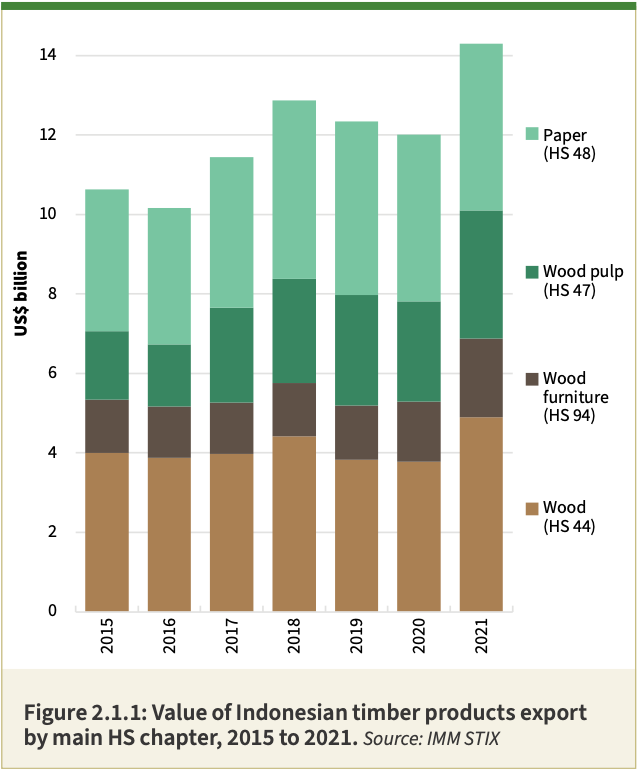
EU27 import value of Indonesian timber products rises 20% in 2021
The total value of EU27 imports of timber products from Indonesia increased by 20% to USD 1.09 billion in 2021,
the highest level in the last decade (Figure 2.2.1). The rise was partly due to a sharp increase in product price and freight rates since the start of the COVID crises due to tight supplies and logistical problems. However, the quantity of imports from Indonesia also increased by 10% to 269,000 tonnes in 2021, the highest level since 2018.
Strong increases in import value were recorded in all four of the leading EU markets for Indonesian wood products in 2021, including the Netherlands (+32% to USD 340 million), Germany (+34% to USD 200 million), Belgium (+23% to USD 130 million), and France (+45% to USD 110 million). Import value from Indonesia was also up 28% to USD 50 million in Spain. In all these markets import value from Indonesia in 2021 was well in excess of the pre-pandemic level in 2019.
Import value into Greece fell 21% to USD 60 million in 2021, but this followed a 40% increase in 2019 and 25% increase in 2020. Import value into Italy fell 11% to USD 60 million in 2021 following an 11% fall the previous year. These downturns in Greece and Italy last year were driven by volatility in the paper sector during the COVID crises.
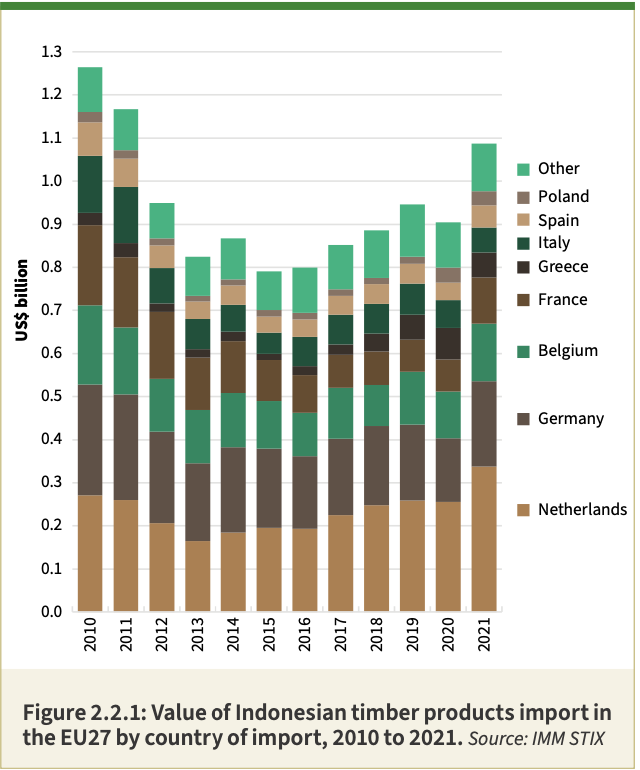
Indonesia takes over 40% share of EU27 tropical plywood market in 2021
EU27 import value of plywood from Indonesia increased 32% in 2021 to USD 70 million. This followed a 21%
decline the previous year. Part of the increase in value was due to rising product prices and freight costs. In quantity terms, EU27 imports of Indonesian plywood increased 7% to 81,600 m3 after a 15% decline the previous year.
Indonesia’s share of import value of tropical plywood into the EU27, which fell from 39% in 2019 to 36% in 2020, rebounded to 41% in 2021. Last year was the first year since 2005 that Indonesia’s share of total EU27 tropical plywood imports exceeded 40%. Much of the gain in direct imports from Indonesia last year was at the expense of tropical hardwood plywood manufactured in China and of indirect imports of tropical hardwood plywood from the UK.
While Indonesia’s share of value of tropical hardwood plywood imported into the EU27 increased last year, share of all hardwood plywood import value fell from 6% in
2020 to 5% in 2021. This continued a longer-term trend of declining share from 7% in 2017, driven mainly by the large rise in imports of birch-faced plywood from Russia between 2016 and 2021 (Figure 2.3.1).
Russia’s invasion of Ukraine is having a massive impact on the EU market for plywood in 2022. IMM interviews with EU plywood importers this year suggest that there is a huge rush for Indonesian products, where mills are being encouraged to ramp up production as much as possible
for the EU market and to relaunch production of thicker film-faced boards, mostly supplied to the EU by Russia
in recent years. If Indonesia is able to increase supply in response to rising demand, its share of this market should increase significantly during 2022.
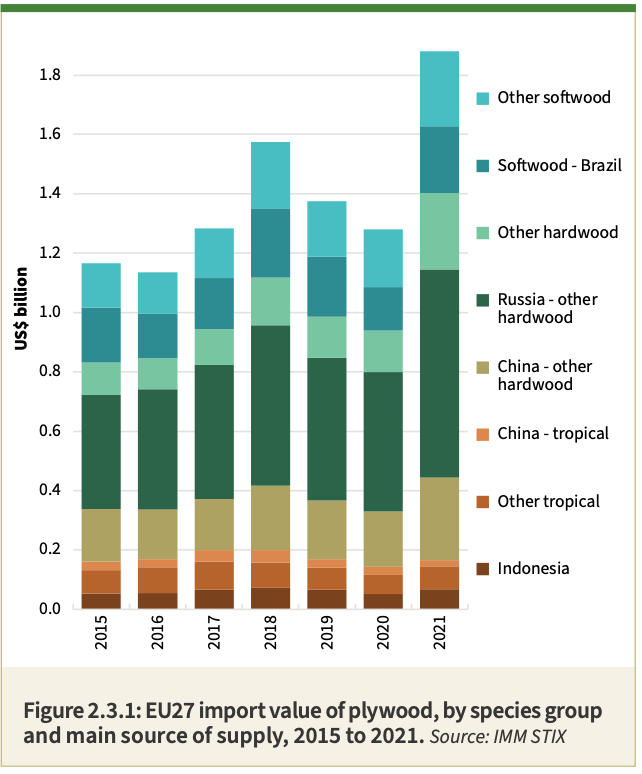
Sharp rise in value of EU27 imports of decking products from Indonesia
EU27 import value of mouldings (mainly bangkirai decking) from Indonesia increased 48% to USD 138 million in 2021 (Figure 2.4.1), partly due to rising prices and freight rates. Import quantity increased by only 16% from 57,000 tonnes to 66,000 tonnes during the year. Rising trade was driven by the exceptionally strong market for garden improvement products in the EU27 and restricted supplies of decking from other parts of the world. Trade would likely have been even higher but for supply constraints and limited access to containers for shipments from Indonesia to Europe.

Indonesia’s share of EU27 import value of mouldings from Lower and Middle Income (LMI) countries increased from 24% in 2020 to 26% in 2021, the first rise in share since 2016 (Figure 2.4.2). Prior to last year, Indonesia was losing share to Brazilian and Russian products in the EU27 mouldings market, to a large extent due to supply limitations in Indonesia since bangkirai decking is still popular in Europe.
EU27 import value of wood doors from Indonesia increased by 39% to USD 50 million in 2021 following a 6% decline the previous year. Import quantity increased 22% to 15,000 tonnes last year, having fallen 2% in 2020. Indonesia accounted for 22% of total EU27 import value of doors from LMI countries in 2021, a rise from 21% in 2020. In 2021, Indonesia was the second largest LMI country supplier of wood doors to the EU27 after China. China’s share of import value in this sector fell from 33% in 2020 to 31% in 2021. However share continued to rise from several countries neighbouring the EU27, including Morocco, Belarus, and Turkey.
EU27 import value of Indonesian wood laminates, mainly laminated window frames and kitchen tops, increased 27% to USD 44 million in 2021. This followed a 17% fall the previous year. For these products the rebound in value was almost entirely due to rising prices and freight rates. Import quantity increased only 3% to 18,000 tonnes in 2021 after a 9% fall the previous year. Indonesia’s share of total import value of laminated wood products from LMI countries fell from 20% in 2020 to 18% last year. Last year all external suppliers of wood laminates to the EU27 lost share to Russia, which overtook Malaysia as the largest supplier. In 2021, Russia accounted for 23% of all EU27 imports of laminated wood products from LMI countries, up from just 14% the previous year.
EU27 import value of wood flooring from Indonesia fell 3% to USD 19 million in 2021, continuing a long-term decline ongoing since the 2008 financial crises. The EU27 wood flooring sector is now almost entirely based on temperate woods, particularly oak which accounts for over 80% of the face veneers used in this sector. EU27 import quantity of Indonesian wood flooring fell 11% to 5,000 tonnes in 2021. This followed a 3% rise the previous year, a short-lived but still surprising gain in the context of the pandemic and the long-term trend. Indonesia’s share of EU27 wood flooring import value from LMI countries fell from 3.9% in 2020 to 2.9% last year. EU27 imports of this product from LMI countries are dominated by China, which accounted for 62% by value in 2021, up from 59% the previous year. Ukraine is the other large LMI supplier of wood flooring to the EU27, accounting for 17% of import value in 2021, down from 18% the previous year.

More encouraging signs for Indonesian wood furniture in EU27 market in 2021
The overall trend for Indonesian wood furniture in the EU27 in 2021 was positive, with encouraging signs for future development of this market. The value of EU27 wood furniture imports from Indonesia increased 46% to USD 461 million in 2021 following a 5% gain the previous year (Figure 2.5.1). As for other products, the rise in import volume was partly owing to rising prices and freight costs. Import quantity increased 12% to 84,000 tonnes after a 1% decline in 2020. The average unit value for Indonesian wood furniture in EU27 imports increased 30% from USD 4226/tonne in 2020 to USD 5476/tonne in 2021. Indonesia accounted for 6.9% of total EU27 wood furniture import value from Lower and Middle Income (LMI) countries in 2021, a slight gain from 6.6% the previous year (Figure 2.5.2).
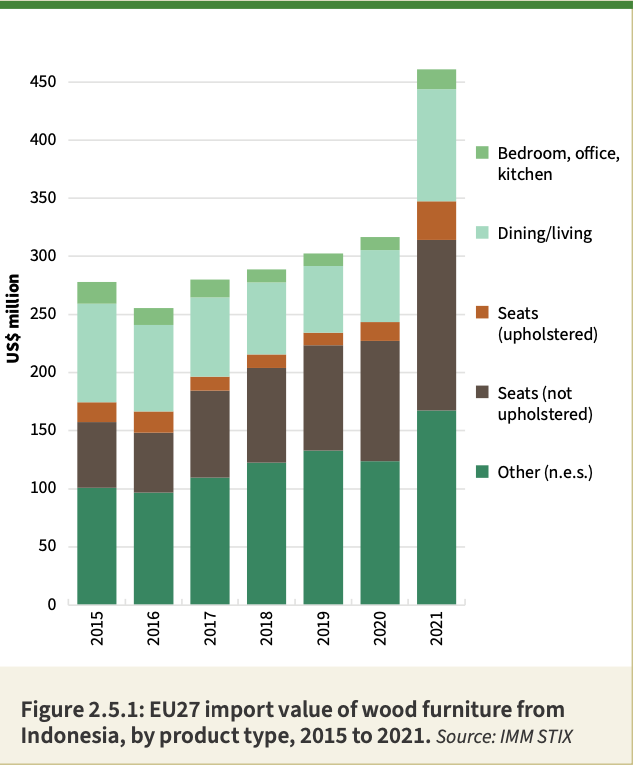
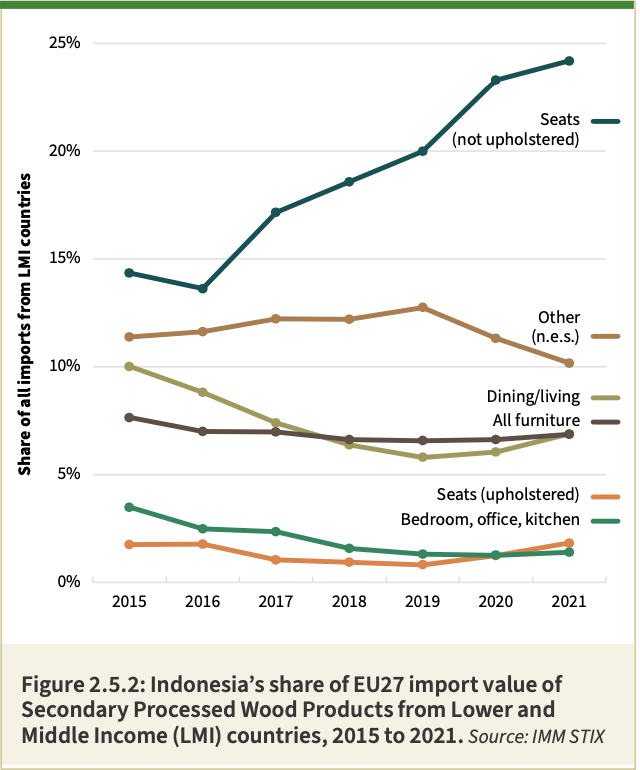
EU27 imports of wood furniture from Indonesia are dominated by outdoor products, particularly due to relatively abundant plantation teak supplies. Unfortunately, the HS product code system has no separate category for garden furniture. However, given that most categories of interior furniture are identified separately (bedroom, office, kitchen, dining/living room, shop), the “other not elsewhere stated (n.e.s.)” category can be assumed
to comprise mainly outdoor furniture. The majority of unupholstered seats imported into the EU27 from Indonesia is also likely to comprise outdoor products.
In 2021, EU27 import value of other n.e.s. furniture from Indonesia increased 35% to USD 167 million. However, in this product category, Indonesia’s share of EU27 import value from LMI countries has fallen during the pandemic, from 12% in 2019 to 10% last year. Share was lost primarily to China, India, Turkey, and Ukraine.
In contrast to other n.e.s. furniture, Indonesia’s share of EU27 import value of non-upholstered seating from LMI countries increased significantly during the pandemic, from 20% in 2019 to 24% last year. Much of the gain was made at the expense of Malaysia. The share of China, still the largest external supplier to the EU27 in this product category, remained level at around 38% between 2019 and 2021.
Of interior furniture products, Indonesia is beginning to make headway in the EU27 dining/living room and upholstered seating sectors. EU27 import value of dining/ living room furniture from Indonesia increased 56% to USD 96 million in 2021 building on an 8% rise the previous year. Indonesia’s share of total import value of this product category from LMI countries increased from 6.6% in 2020 to 6.9% in 2021. EU27 import value of upholstered seating from Indonesia increased by 103% to USD 33 million last year. Share of total import value from LMI countries increased from 1.2% to 1.8%.
EU imports of Indonesian paper products down 26% in 2021
EU27 import value of paper products from Indonesia fell 26% to USD 194 million in 2021. This followed a 4% fall the previous year (Figure 2.6.1). In quantity terms, imports fell 38% to 158,000 tonnes in 2021. Indonesia’s share of total EU27 import value of paper products from LMI countries fell from 6% in 2020 to 3% in 2021. Share was lost primarily to China, which accounted for half of all EU27 import value of paper products from LMI countries during the year.
Paper imported from Indonesia into the EU27 consists primarily of uncoated papers (in large sheets or rolls for writing and printing) and sanitary paper products. Imports of both these product categories from Indonesia fell sharply last year, only partly compensated by a rise in import value of kaolin-coated paper products. The decline in imports last year occurred across all the main EU27 destinations for Indonesian paper including Greece, Belgium, Italy and Spain.
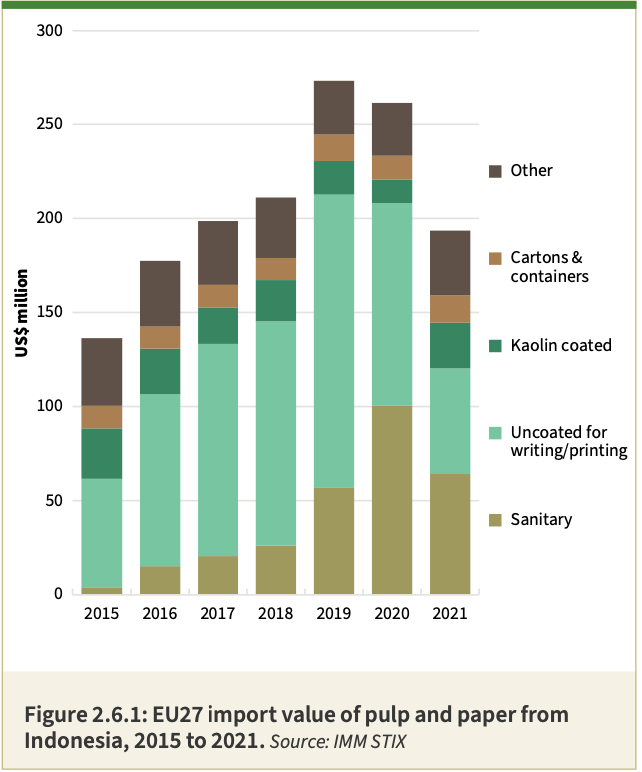
Indonesian log supply continues to rise in 2021
Indonesian log supply increased 3% to 63.2 million m3 in 2021, continuing the long-term rising trend driven mainly by rising plantation production (footnote 1) destined for the pulp and paper sector (Figure 2.7.1).

According to Indonesian Ministry of Environment and Forestry data, in 2021 plantation production increased 4% to 47.1 million m3, building on a 13% gain the previous year. Community forest production (footnote 2) also increased in 2021, by 11.6% to 9.5 million m3 after an 8% decline the previous year. Logs from land clearing operations (footnote 3) increased 27% from a small base to 0.4 million m3 in 2021, the first rise since 2018. These gains offset a 7% decline in production in natural forest concessions (footnote 4) to 4.5 million m3 and a 97% decline in log imports which were negligible in 2021.
In 2021, 75% of Indonesia’s log supply came from industrial plantations, 15% from community forests, 7% from natural forest concessions, and 3% from other domestic sources (footnote 5). There was virtually no supply from log imports.
Footnotes
1. Production from ‘plantations’, as defined here, is dominated by supply for industrial plantations (IUPHHK Pada Hutan Tanaman Industri atau HTI, mainly for the pulp and paper sector), but also includes smaller volumes from Perum Perhutani (state plantations, mainly teak in Java and Madura), and from ‘other plantations’ (IUPHHK Pada Hutan Tanaman Rakyat atau HTR).
2. Production from ‘community forests’ is defined here to include supply from IUPHHK Dalam Hutan Desa (Village forest), IUPHHK Dalam Hutan Kemasyara katan (Community forest), Hutan Rakyat (Peoples Plantations), and Kayu Perkebunan (Woodlots)
3. Production from ‘land clearance operations’ is defined here to include wood from LC Penyiapan Lahan Penanaman HTI.
4. Production from ‘natural forest concessions’ is defined to include wood from IUPHHK Hutan Alam
5. Supply from ‘other domestic sources’ is defined here to include: ‘Izin Lainnya Yang Sah (ILS) Atau IPK’ (other legal permits), ‘Pemilik atau Pedagang Hasil Hutan Kayu Bulat Dan Asal Usul Yang Sah’ (private sources), and ‘IPHHK Lain’ (other supplies to wood processing industry).
